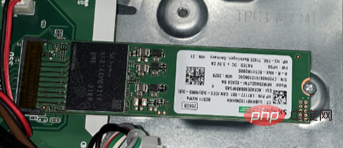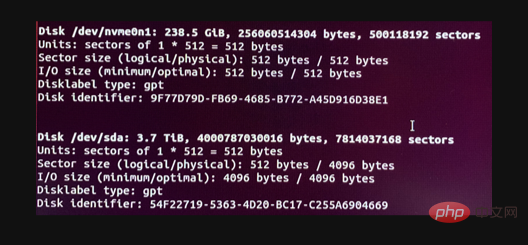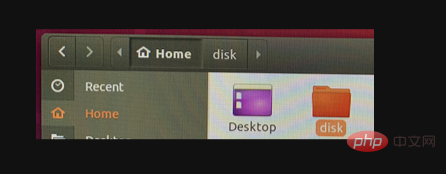Can linux use solid state?
Linux can use solid state. The method of mounting a solid state drive is: 1. Disassemble the chassis, find the m.2 ssd slot, insert the solid state drive and tighten the screws; 2. Pass "sudo fdisk -l " command to view hard disk information and create a mounting directory; 3. Format the hard disk to be mounted and edit the "/etc/fstab" file; 4. Execute the "sudo reboot" command to restart the service.

#The operating environment of this tutorial: linux5.9.8 system, Dell G3 computer.
Can Linux use solid state?
Ubuntu system mounts solid state drive
Applicable scenarios:
Ubuntu operating system is installed On a mechanical hard drive, a solid-state drive needs to be mounted to speed up code compilation.
(1) Install solid state drive
Tools: Phillips screwdriver and screws
Instructions: Disassemble the chassis, find the m.2 ssd slot, insert the solid state drive and tighten the screws. 
(2) Check your own hard disk information
Command: sudo fdisk –l

Instructions: Check the disk capacity size, it is determined that sda is the mechanical hard drive that has been partitioned to install the operating system, and nvme0n1 is the solid-state drive that needs to be mounted. 
(3) Create a mounting directory (actually it is a folder in ubuntu)
Command: mkdir directory

Instructions : Use mkdir disk here. After running the command, a folder named disk will appear in home. 
(4) Format the hard disk that needs to be mounted
Command: sudo mkfs.ext4 /dev/nvme0n1
Instructions: Prompt to confirm the format, enter Y.

done appears, that is, formatting is completed
(5) Record the UUID of the hard disk to be mounted
Command: sudo blkid
is displayed as shown below: 
#Instructions: Copy the UUID of nvme0n1 of the hard disk to be mounted, which will be used below.
(6) Edit the /etc/fstab file
Command sudo nano /etc/fstab

Instructions: Start editing now, because you are using nano edit command, so move the up and down keys on the keyboard to the last line, enter #/dev/nvme0n1
UUID=paste home/mi/disk ext4 defaults 0 0 (the account directory name/mi is missing and the mount is unsuccessful)
(7) Then restart
Command: sudo reboot
(8) Check whether the mounting is successful
Open the home directory, find the disk directory, and the disk icon will appear It is mounted successfully. 
You can also command to view
Command: df -h


(9) Add root permissions to the folder
In the terminal, enter sudo chmod 777 -r /home/mi/disk
(10) Command descriptions used and common Linux commands
fdisk: Used to check the number of hard disks and partitions attached to the machine.
mkdir: used to create directories.
mkfs: Used to create a linux file system on a specific partition.
blkid: Used to query the file system type, LABEL, UUID and other information used by the system's block device.
nano/vim: Text editor.
reboot: Restart.
df: Used to display the current disk usage statistics of the file system on the Linux system.
Related recommendations: "Linux Video Tutorial"
The above is the detailed content of Can linux use solid state?. For more information, please follow other related articles on the PHP Chinese website!

Hot AI Tools

Undresser.AI Undress
AI-powered app for creating realistic nude photos

AI Clothes Remover
Online AI tool for removing clothes from photos.

Undress AI Tool
Undress images for free

Clothoff.io
AI clothes remover

AI Hentai Generator
Generate AI Hentai for free.

Hot Article

Hot Tools

Notepad++7.3.1
Easy-to-use and free code editor

SublimeText3 Chinese version
Chinese version, very easy to use

Zend Studio 13.0.1
Powerful PHP integrated development environment

Dreamweaver CS6
Visual web development tools

SublimeText3 Mac version
God-level code editing software (SublimeText3)

Hot Topics
 deepseek web version entrance deepseek official website entrance
Feb 19, 2025 pm 04:54 PM
deepseek web version entrance deepseek official website entrance
Feb 19, 2025 pm 04:54 PM
DeepSeek is a powerful intelligent search and analysis tool that provides two access methods: web version and official website. The web version is convenient and efficient, and can be used without installation; the official website provides comprehensive product information, download resources and support services. Whether individuals or corporate users, they can easily obtain and analyze massive data through DeepSeek to improve work efficiency, assist decision-making and promote innovation.
 How to install deepseek
Feb 19, 2025 pm 05:48 PM
How to install deepseek
Feb 19, 2025 pm 05:48 PM
There are many ways to install DeepSeek, including: compile from source (for experienced developers) using precompiled packages (for Windows users) using Docker containers (for most convenient, no need to worry about compatibility) No matter which method you choose, Please read the official documents carefully and prepare them fully to avoid unnecessary trouble.
 Ouyi okx installation package is directly included
Feb 21, 2025 pm 08:00 PM
Ouyi okx installation package is directly included
Feb 21, 2025 pm 08:00 PM
Ouyi OKX, the world's leading digital asset exchange, has now launched an official installation package to provide a safe and convenient trading experience. The OKX installation package of Ouyi does not need to be accessed through a browser. It can directly install independent applications on the device, creating a stable and efficient trading platform for users. The installation process is simple and easy to understand. Users only need to download the latest version of the installation package and follow the prompts to complete the installation step by step.
 BITGet official website installation (2025 beginner's guide)
Feb 21, 2025 pm 08:42 PM
BITGet official website installation (2025 beginner's guide)
Feb 21, 2025 pm 08:42 PM
BITGet is a cryptocurrency exchange that provides a variety of trading services including spot trading, contract trading and derivatives. Founded in 2018, the exchange is headquartered in Singapore and is committed to providing users with a safe and reliable trading platform. BITGet offers a variety of trading pairs, including BTC/USDT, ETH/USDT and XRP/USDT. Additionally, the exchange has a reputation for security and liquidity and offers a variety of features such as premium order types, leveraged trading and 24/7 customer support.
 Get the gate.io installation package for free
Feb 21, 2025 pm 08:21 PM
Get the gate.io installation package for free
Feb 21, 2025 pm 08:21 PM
Gate.io is a popular cryptocurrency exchange that users can use by downloading its installation package and installing it on their devices. The steps to obtain the installation package are as follows: Visit the official website of Gate.io, click "Download", select the corresponding operating system (Windows, Mac or Linux), and download the installation package to your computer. It is recommended to temporarily disable antivirus software or firewall during installation to ensure smooth installation. After completion, the user needs to create a Gate.io account to start using it.
 Ouyi Exchange Download Official Portal
Feb 21, 2025 pm 07:51 PM
Ouyi Exchange Download Official Portal
Feb 21, 2025 pm 07:51 PM
Ouyi, also known as OKX, is a world-leading cryptocurrency trading platform. The article provides a download portal for Ouyi's official installation package, which facilitates users to install Ouyi client on different devices. This installation package supports Windows, Mac, Android and iOS systems. Users can choose the corresponding version to download according to their device type. After the installation is completed, users can register or log in to the Ouyi account, start trading cryptocurrencies and enjoy other services provided by the platform.
 gate.io official website registration installation package link
Feb 21, 2025 pm 08:15 PM
gate.io official website registration installation package link
Feb 21, 2025 pm 08:15 PM
Gate.io is a highly acclaimed cryptocurrency trading platform known for its extensive token selection, low transaction fees and a user-friendly interface. With its advanced security features and excellent customer service, Gate.io provides traders with a reliable and convenient cryptocurrency trading environment. If you want to join Gate.io, please click the link provided to download the official registration installation package to start your cryptocurrency trading journey.
 Why does an error occur when installing an extension using PECL in a Docker environment? How to solve it?
Apr 01, 2025 pm 03:06 PM
Why does an error occur when installing an extension using PECL in a Docker environment? How to solve it?
Apr 01, 2025 pm 03:06 PM
Causes and solutions for errors when using PECL to install extensions in Docker environment When using Docker environment, we often encounter some headaches...






